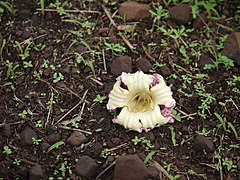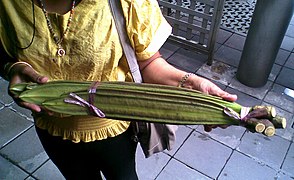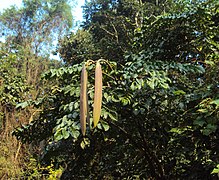Oroxylum indicum
| Oroxylum indicum | ||||||||||||
|---|---|---|---|---|---|---|---|---|---|---|---|---|

Oroxylum indicum |
||||||||||||
| Systematics | ||||||||||||
|
||||||||||||
| Scientific name of the genus | ||||||||||||
| Oroxylum | ||||||||||||
| Vent. | ||||||||||||
| Scientific name of the species | ||||||||||||
| Oroxylum indicum | ||||||||||||
| ( L. ) Benth. ex short |
Oroxylum indicum is a tree in the trumpet tree family from India , Nepal to southern China and from the more northerly Southeast Asia . It is the only species in the genus Oroxylum .
description
Oroxylum indicum grows as a semi-evergreen and fast-growing tree to about 13-18 meters high. The trunk diameter reaches about 40 centimeters. The bark is brownish-gray to grayish.
The opposite, stalked and long foliage leaves at the branch ends are usually doubly imparipinnate, more rarely triply, with 3–9 leaflets on each secondary rachis. The leaves are about 70-160 centimeters long with a petiole, with swollen nodes, especially on the main rhachis. The entire and stalked, pointed to pointed or pointed to tailed, slightly leathery, bald leaflets are ovate to obovate. They are up to 13-15 centimeters long and 9-10 centimeters wide. The base of the leaflet is pointed to rounded or slightly heart-shaped. The stipules are missing.
Terminal, upright and dense, long-stemmed, multi-flowered racemose inflorescences with a thick rachis are formed. The whitish or cream-colored to yellowish, reddish-purple and stalked, unpleasantly smelling, five-fold, very large, hermaphrodite flowers have a double flower envelope . The thick flower stalk is up to 6–7 inches long. The calyx sits with a "joint" on the flower stem. The green, reddish-purple, leathery and bare, about 2.5–4 centimeters long sepals are fused tubular, with very small to minimal lobes, tips. The bell-shaped, two-lipped crown with a wide throat and shorter, recessed, ribbed, frilly, rounded, slightly fine-haired lobes is up to 6-10 centimeters long. The 5 stamens , with hairy stamens at the base, are attached in the middle of the corolla tube and just protrude to include. The elongated and two-chamber ovary is upper constant with a long, slightly protruding pen and zweilappiger scar . There is a meaty discus present. The flowers bloom only a few hours late in the evening and are pollinated by bats , after which the crown is shed.
Flat, up to 50–110 centimeters long and 5–10 centimeters wide, narrow, short-winged and woody, brownish, bald, linear-lanceolate, sword-shaped, many-seeded and short-pointed capsule fruits are formed. The many (150-300) beige and flat seeds are winged in a semicircle. They are about 5–8 inches long with wings. The papery and whitish wing is thin, fine and translucent.
The number of chromosomes is 2n = 28.
use
The fruits are edible, the young are boiled and the older are grilled. The seeds are also eaten, the young are grilled, and the ripe ones are used in drinks.
The young leaves, flowers and buds are also eaten, either raw or cooked.
The seeds, leaves and bark are used medicinally.
The seeds can also be used as filling material.
The soft and fibrous wood is rarely used. It can be used for paper making or for matches .
literature
- PJA Kessler, Hoang Van Sam, Khamseng Nanthavong: Trees of Laos and Vietnam: A Field Guide to 100 Economically or Ecologically Important Species. In: Blumea 49 (2-3), 2004, pp. 201-349, doi: 10.3767 / 000651904X484298 .
- JW Kadereit : The Families and Genera of Vascular Plants. Vol.VII: Flowering Plants Dicotyledons , Springer, 2004, ISBN 978-3-642-62200-7 (Reprint), pp. 10 f, 23.
- Christophe Wiart: Medicinal Plants of Bangladesh and West Bengal. CRC Press, 2019, ISBN 978-1-1387-3516-3 , 17.1.
Web links
- Oroxylum indicum at Useful Tropical Plants.
- Oroxylum indicum at PROTA.
- Oroxylum indicum in the Flora of China, Vol. 18.
- Oroxylum indicum at Phytoimages (pictures).
Individual evidence
- ↑ Tuanjit Srithongchuay, Sara Bumrungsri, Ekapong Sripao-raya: The pollination ecology of the late-successional tree, Oroxylum indicum (Bignoniaceae) in Thailand. In: Journal of Tropical Ecology. 24 (05), 2008, pp. 477-484, doi: 10.1017 / S026646740800521X .




